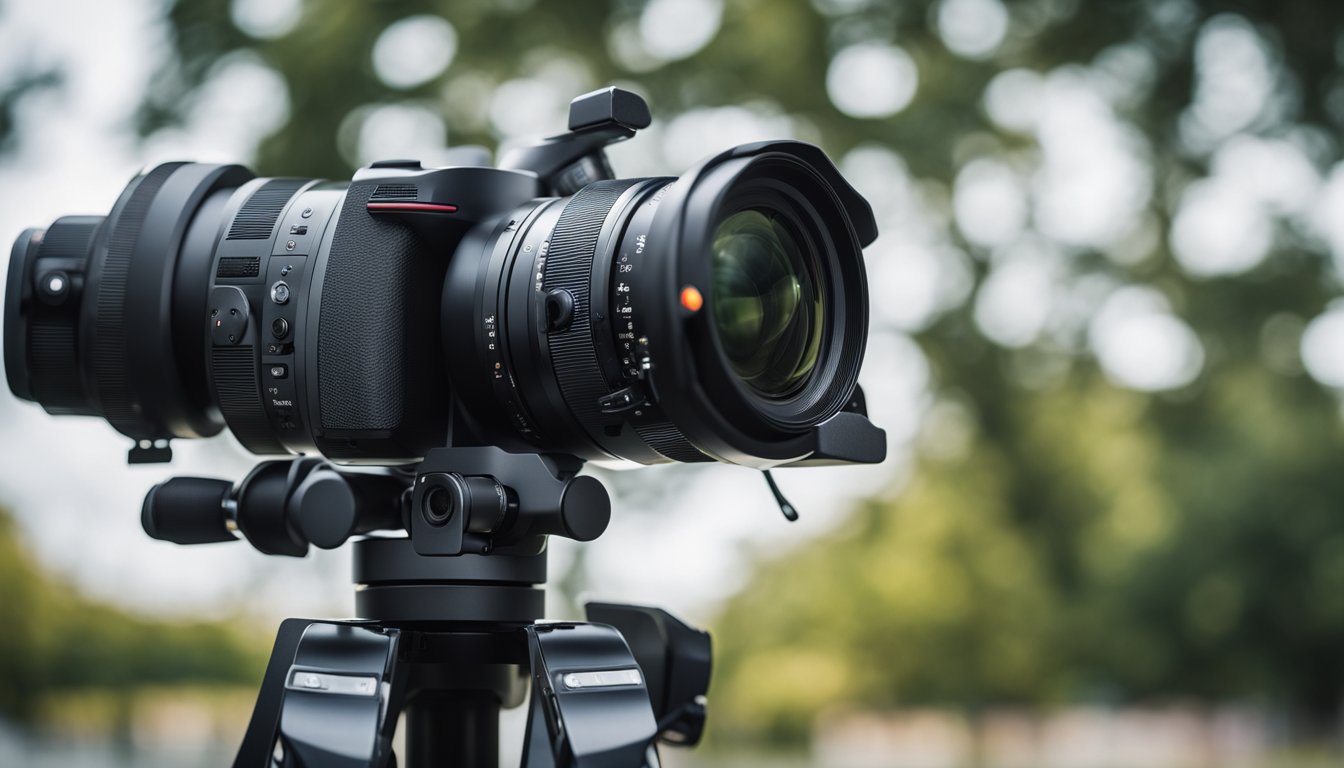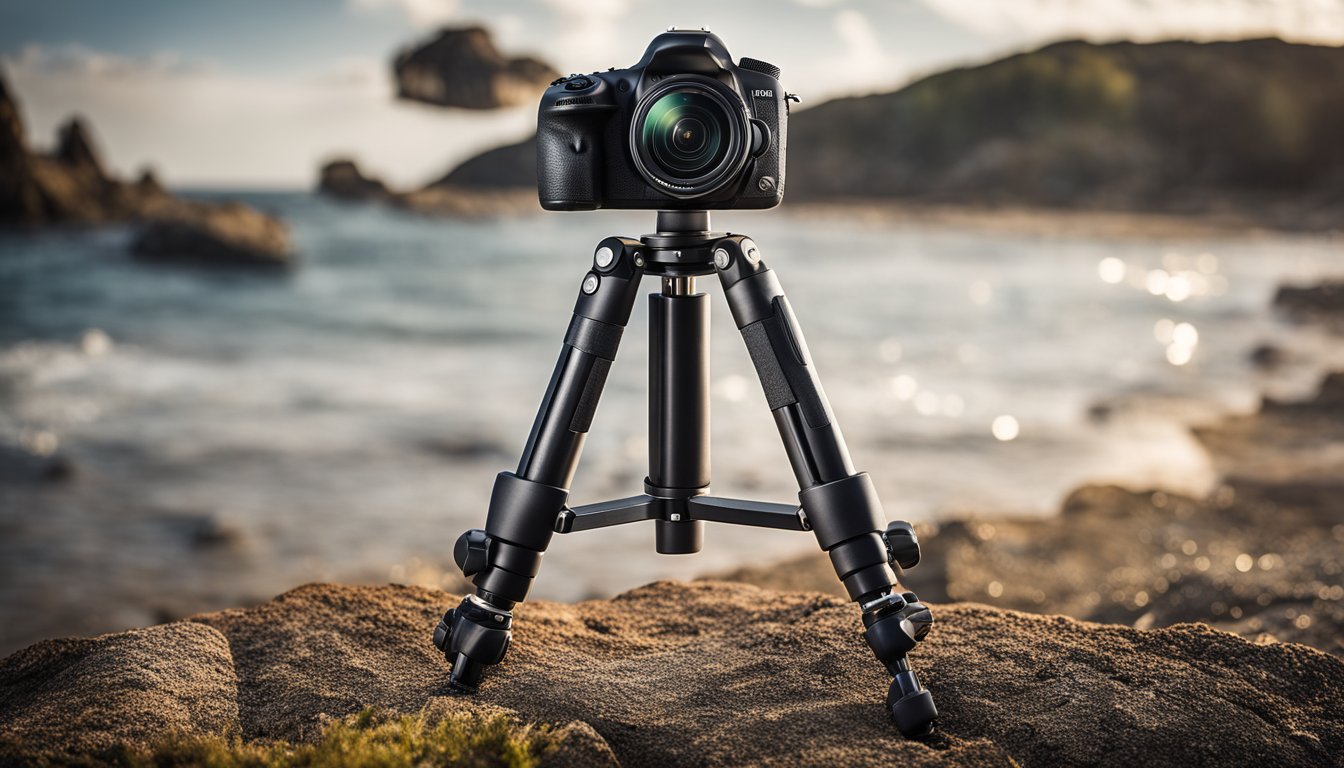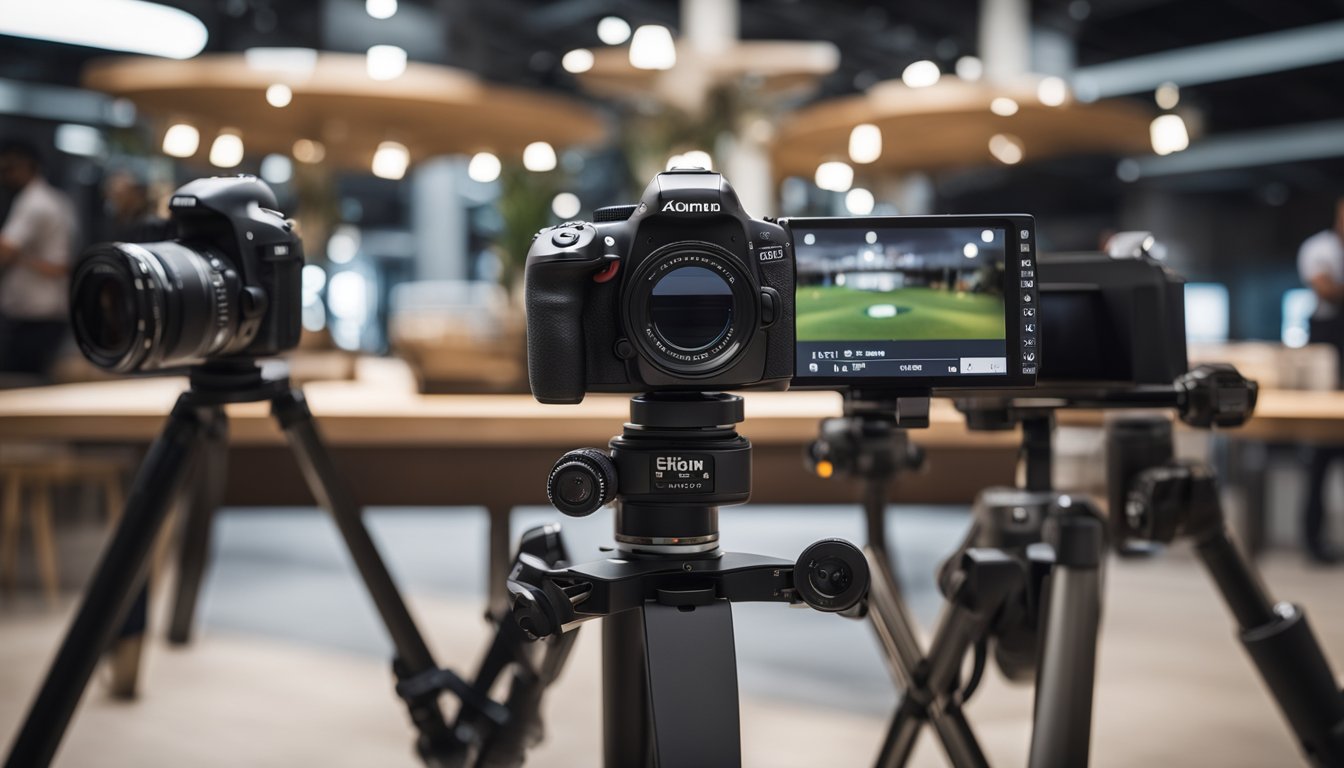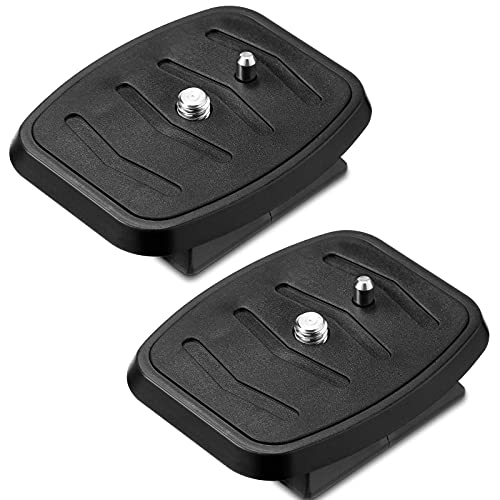When venturing into photography, especially with 360 cameras, having the right tripod can make a significant difference in the quality and stability of your shots. Tripods for 360 cameras are specially designed to support the camera’s round lenses and unique viewing angles without interfering with the shot. The best tripod for a 360 camera will have a slim profile to minimize its appearance in the 360-degree field of view and should also provide stability to capture sharp images without vibration or movement.

Choosing the right tripod involves knowing the distinct features that accommodate the needs of 360-degree photography. These features include robust materials that can handle the camera’s weight, tripod heads that allow for precise adjustments, and options for enhanced stability to counteract environmental factors such as wind. Travel tripods offer portability for photographers on the move, while specialized tripods cater to the demands of video creation with smooth panning capabilities. Additionally, considering tripod accessories can expand the functionality and versatility of your setup.
Key Takeaways
- Selecting a tripod with a slender profile is vital for 360 photography to ensure it remains unseen in your shots.
- Look for tripods with precise adjustment capabilities and high stability to improve image quality.
- Assess additional accessories to fully equip your tripod for various photography scenarios.
Understanding Tripod Basics
When you’re looking to support your 360 camera, knowing the fundamentals of tripods can help you choose the perfect match for your photography needs.
Components of a Tripod
The tripod consists of three main parts. The legs provide the stability required for sharp images, and you can adjust their height and angle to handle different terrains. Typically, they are made from materials like aluminum or carbon fiber. At the top of the tripod, the ball head allows your camera to pan and tilt smoothly, giving you the freedom to capture 360-degree scenes with precision.
- Legs: The foundation offering stability and support
- Ball Head: Enables versatile camera movement and angle adjustment
Different Types of Tripods
You’ll find several types of tripods made to meet specific photographic circumstances. A monopod has a single leg for greater mobility, useful when you’re on the move. The tabletop tripod is compact and perfect for low-angle shots or when you’re working with limited space. For standard use, however, a full-sized tripod with sturdy tripod legs will provide the best stability for your 360 camera.
- Monopod: Increased mobility with one leg
- Tabletop Tripod: Compact design for space-constraint situations
- Full-sized Tripod: Optimal stability for general use
Choosing the Right Material

When you’re on the hunt for the perfect tripod for your 360 camera, the material it’s constructed from is crucial. You want something that balances strength with portability, and the choice typically comes down to two contenders: aluminum and carbon fiber.

Aluminum vs. Carbon Fiber Tripods
Aluminum tripods are a go-to for many due to their affordability and robustness. They can take a few knocks and still perform well, which is comforting when you’re out and about.
On the other hand, carbon fiber tripods are revered for being significantly lightweight yet incredibly sturdy. They can make transporting your tripod much less of a hassle, especially if you have a lot of gear to carry.
| Material | Weight | Strength | Cost |
|---|---|---|---|
| Aluminum | Heavier | Strong | More Affordable |
| Carbon Fiber | Lighter | Very Strong | Pricier |
Durability and Weight Considerations
When pondering durability, think about the conditions you’ll be facing. If you’re frequently out in rough terrain, aluminum’s resilience might be appealing. On the flip side, carbon fiber, despite its lightness, often exhibits excellent durability and might surprise you with how well it can withstand demanding use.
It’s all about finding that sweet spot where durability meets lightweight practicality. After all, nobody wants to lug around a heavy tripod that makes shooting a chore. Your perfect pick should feel like a natural extension of your gear, steadfast in its support but never a burden to bear.
Tripods for Different Cameras
Choosing the right tripod for your camera ensures stability and precision in your photography, no matter what device you’re using. Whether you own a DSLR, a smartphone, or a mirrorless system, the right tripod can greatly enhance your shooting experience.
Tripods for DSLRs
For DSLR cameras, which tend to be heavier, you need a sturdy tripod that can comfortably support the weight. The 3 Legged Thing Winston 2.0 is known for its robust construction and stability. Here is a quick rundown:
- Weight Capacity: Check that the tripod can handle your camera’s weight.
- Height and Portability: Ensure that it extends to your desired height without compromising on portability.
Tripods for Smartphone Photography
« 360 Cameras Comparison: Choosing the Best for Your Needs
How to Make Money with a 360 Camera: Profit from Every Angle »
If you’re into smartphone photography, a tripod that’s lightweight and easy to carry is essential. The versatility of the Vanguard VEO 3+ 303CBS is suitable for iPhone or other smartphone photographers who are on the go. Keep in mind:
- Mount Type: Ensure it comes with or is compatible with a smartphone adapter.
- Flexibility: Look for tripods that allow for a range of angles and orientations.
Tripods for Mirrorless Systems
Mirrorless cameras are lighter than DSLRs, so you have more flexibility in choosing a tripod. However, stability should not be compromised. The compact design of the Koolehaoda MT-03 legs is often recommended for its balance of lightweight and stable design considerations. Consider these features:
- Material: Carbon fiber tripods offer durability and lightness.
- Leg Locks: Make sure they are reliable and easy to adjust.
Each camera system has its own requirements, but the right tripod can meet them and even enhance your photography skills. Remember, a good tripod is an investment in the quality of your shots and the longevity of your equipment.
Tripod Heads and Their Importance
When you’re capturing 360-degree panoramas or immersive video, the right tripod head can make all the difference. It’s not just a platform for your camera; it determines control and fluidity in your shots.
Ball Heads for Flexibility
Ball heads are the go-to choice for photographers who value speed and versatility. It’s a simple concept: a ball-joint mechanism allows for quick adjustments in any direction. This design grants you the ability to rapidly switch between angles and orientations, making it especially handy for dynamic shooting environments. For example, the Koolehaoda MT-03 legs combined with a sturdy ball head can significantly expand your 360 camera’s potential.
Fluid Heads for Smoother Movements
Fluid heads are preferred by videographers for their precision and the silky smooth movements they facilitate. This type of head employs a hydraulic dampening system that adds resistance to movements, which can be fine-tuned to achieve that perfect pan or tilt. It’s essential to ensure your fluid head can support the weight of your 360 camera for the best performance. Manfrotto’s range of fluid heads, noted for their stability and balance, feature various models tailored to different weight classes and use cases.
Features for Enhanced Stability
When you’re capturing the world in 360 degrees, stability is key. Upgraded features in tripods help ensure your 360 camera remains steady, even on the most challenging terrains.

Securing Your Setup on Uneven Surfaces
To keep your 360 camera stable on uneven grounds, look for tripods with spiked feet or rubberized grips that can hold fast on rocky or slippery surfaces. Additionally, some tripods provide features like adjustable leg angles, enabling you to customize the stance of your set up for maximum balance.
Weight and Load Capacity
Your tripod’s ability to support your camera is determined by its weight and load capacity. A sturdy tripod, such as the Koolehaoda MT-03, is desirable, especially if it couples lightness with the strength to support heavier cameras without wobble. Look for a tripod that can support at least 15.5 lbs to ensure it can handle your equipment securely.
Travel Tripods for On-the-Go Photography
When you’re capturing memories with your 360 camera, having a travel tripod that’s both lightweight and compact is crucial. Let’s explore options that won’t weigh you down and can adapt to a monopod for flexibility.
Lightweight and Foldable Designs
Your tripod should be easy to carry, meaning a design that’s lightweight and foldable is ideal. Look for tripods crafted from materials like carbon fiber, which offers strength without the bulk. For instance, the Benro Travel Angel is a model that combines these qualities, folding down to a manageable size without compromising on stability.
Travel Tripods with Monopod Conversion
Versatility on the go can be just as important as stability. Some tripods offer a monopod conversion feature, which is perfect for situations where you’re in tighter spaces or need to move quickly. The 3 Legged Thing Punks Corey 2.0 Compact Travel Tripod is an example of a travel-friendly tripod that transforms into a monopod, letting you switch your setup to match the demands of your environment with ease.
Specialized Tripods for Video
When capturing video, it’s crucial to have a stable platform that allows for fluid motion and accommodates the heftier gear typical of video setups.
Tripods with Smooth Panning for Videography
For videography, a tripod with smooth panning is non-negotiable. You want silky transitions from one scene to another, which is where tripods like the Manfrotto Befree Live Video Tripod Kit excel. This tripod offers a fluid drag system, ensuring your panning motions are controlled and free from jerks. Its compact design also makes it ideal for videographers on the move.
Heavy-Duty Video Tripods for Larger Setups
If you’re working with heavier cameras and accessories, a heavy-duty video tripod is what you need. These tripods provide the sturdiness required to support your gear without sacrificing the steadiness needed for professional-grade video recording. They are built with stronger materials and typically have broader bases for enhanced stability.
Tripod Accessories to Enhance Your Experience
To get the most out of your 360 camera, investing in the right tripod accessories can significantly enhance your photography experience. From improving functionality to unlocking creative potential, the right add-ons will make your photo sessions more productive and enjoyable.
Adding Functionality with Accessories
When you start to explore the range of tripod accessories, you’ll discover that they can add much-needed functionality to your setup. Quick-release plates make attaching and detaching your camera a swift process, saving you time when you’re trying to capture those fleeting moments. Similarly, a bubble level can ensure your camera is perfectly aligned, which is crucial for 360-degree photography to avoid uneven seams in the final image.
Tripod heads are essential for smooth panning and tilting, and choosing one with a fluid drag system can vastly improve your video shots, providing that smooth, cinematic feel. Meanwhile, extendable segments in tripod legs or center columns increase the height variety and can help you capture images from new angles, handy for shots that require an elevated perspective.
Creative Uses with Extensions and Spikes
Tripod accessories can unlock new creative opportunities for your photography or videography. Extension arms or booms offer the chance to elevate your camera further or to position it in spaces that the tripod itself can’t reach. Look for arms that are sturdy yet flexible to navigate difficult shots.
For outdoor shoots, metal spikes can be invaluable. They provide extra grip on soft ground and can prevent your tripod from slipping on uneven terrain. Some of the most useful tripod accessories include these spikes, which often come with a standard 3/8″ thread, compatible with most professional tripods.
By focusing on ease of use and considering tech-specific features, such as those for are tailored to 360 cameras, you can turn a simple tripod into a versatile tool that caters to practically any shooting scenario.
Top Tripod Brands and Models

When you’re shopping for the best tripod to support your 360 cameras, it’s worthwhile to consider a mix of premium and budget-friendly options. Based on your needs and budget, you can opt for high-end models from Manfrotto and Gitzo or seek affordable quality from brands like Amazon Basics and Benro.
Premium Choices from Manfrotto and Gitzo
Manfrotto: a renowned name in the world of tripods, Manfrotto’s offerings are synonymous with durability and precision. A top choice for serious photographers is their MT055CXPRO3 carbon fiber model – it’s sturdy, lightweight, and features a 90-degree column mechanism.
Gitzo: Gitzo tripods are regarded as some of the most premium on the market. They’re known for exceptional quality and a price to match. Their GT3543LS Systematic Tripod is a favorite among professionals for its robust build and stability in various shooting conditions.
Affordable Quality from Amazon Basics and Benro
-
Amazon Basics: If you need a functional tripod without breaking the bank, Amazon Basics provides reliable options. Their 60-inch lightweight tripod is well-suited for casual use and lighter cameras, offering ease of use at a very affordable price point.
-
Benro: For those who seek a balance between cost and performance, Benro’s tripods are a fantastic middle ground. Their Rhino FRHN34CVX30 model, for example, gets you professional features like a carbon fiber build and high weight capacity, without the premium cost.
Purchasing Tripods Online
When you’re looking for a tripod for your 360 camera, shopping online can help you find a great selection and competitive prices. Let’s navigate through the process to land the best deal and product for your needs.
Finding the Best Deals on Amazon
Amazon is known for its vast selection and competitive pricing. To find the best deals on tripods for 360 cameras:
- Use the search bar to look for “360 camera tripod.”
- Sort the results by customer ratings to see highly recommended products.
- Keep an eye out for “Today’s Deals” or “Lightning Deals” that can save you money.
- Check if the product is Prime eligible for faster shipping.
By comparing prices and considering Amazon special offers, you can often snag a tripod at a lower price without compromising on quality.
What to Look For in Online Reviews
Online reviews are a goldmine of user experience. Here’s how to use them to your advantage:
- Scan for common themes: If several reviewers mention that a tripod is particularly durable or lightweight, it’s likely a reliable feature.
- Look at the reviewers’ photos: Real-world images can be more telling than product descriptions.
- Consider the number of reviews: A tripod with hundreds of positive reviews is typically a safer bet than one with just a handful.
- Be wary of overly negative or positive reviews: Aim to read a mix to get a balanced view.
Understanding the context of each review can give you a clearer picture of what to expect from the tripod you’re eyeing.
Frequently Asked Questions
When you’re exploring tripod options for your 360 camera, it’s essential to consider compatibility, portability, and specific design features that enhance your photography experience. Here are some straightforward answers to common questions on finding the right tripod for your needs.
How can I ensure a tripod is compatible with my 360 camera?
Check the connecting thread of your 360 camera and ensure it matches the tripod’s mount specification. Most cameras use a standard 1/4-inch thread, which is commonly supported by tripods.
What are the top recommended tripods for outdoor 360 photography?
For outdoor use, look for tripods that have sturdy legs and can be anchored securely. The Koolehaoda MT-03 legs are highly regarded for their stability and versatility in various terrains.
Are there any tripods specifically designed for iPhone 360 camera use?
Several tripods cater to iPhone users, offering secure mounts and sometimes integrated remote controls to facilitate 360 photography. Check for tripods that list smartphone compatibility.
What features make a tripod suitable for 360 video recording?
A tripod suitable for 360 video should offer smooth panning capabilities, solid stabilization, and sometimes extended height options without obstructing the camera’s view.
How does a monopod compare to a tripod when shooting with a 360 camera?
Monopods are more portable and quicker to set up than tripods but may not offer the same level of stability, especially in windy conditions or on uneven surfaces.
What are the best 360 camera tripods for travelers who need portability?
Travelers should look for lightweight, compact tripods that are easy to carry. The Slik Lite AL-420 is known for being sturdy yet compact enough for travel.







